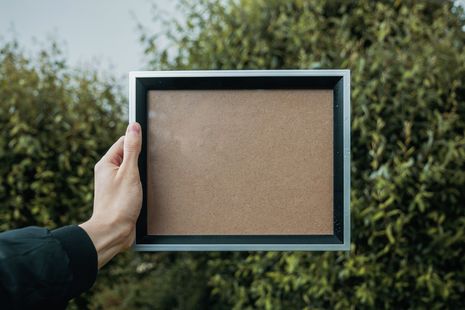‘Matt or shiny? White or wooden?’ The delicate art form of framing
Arts Writer Sasha Brealey reflects on her daunting but deeply rewarding foray into framing pictures – and offers a few tips on how to choose a frame for yourself

If you wandered into the art supplies shop I used to work in – it was tucked away in North London, quirky but horrifically priced – you would see one corner that was always devoid of staff. I remember playing rock-paper-scissors to decide who would go over to the poor customer trapped there. 'What art supply could possibly cause this degree of anxiety?' you may ask. I quiver to tell you that it was the framing section. I used to sit and curse whoever came up with idea of a custom framing service, but in hindsight, it has forever altered the way in which I perceive art, so maybe the fear was worth the finding.
There was something so exciting and daunting about holding someone else’s memory in your hands
Before working here, I would never pay attention to the frame of a painting or photo. But suddenly, with customers handing me these treasured memories in a way that was both sensitive and proud, trusting my (ill-informed and mostly evasive) advice on what frame would suit it best, I was forced to develop a hyperawareness to the artform of framing. After a friendly chat about the story behind the piece, a tense set of decisions would suddenly appear: what colour should the frame be? Matt, shiny or wooden? Do you want the piece to fill the frame, or would you prefer a blank space behind it? If so, what colour should the space be? How thick would you like the frame? Oh, sorry that frame is too thin and won’t support your picture … Oh, and what kind of glass would you like? This one is anti-refectory, this one is near invisible, this one can highlight shiny tones in the picture!
Very quickly, I had to forge a fresh skillset – an eye for the delicate art of framing. I became accustomed to the way a darker frame brought out the warmer shades in a picture, how a black one-inch frame against a broad white background could elicit a classy minimalism, how a shiny frame should be avoided in a room facing a window with sunlight. There was something so exciting and daunting about holding someone else’s memory in your hands and being responsible for how it would subconsciously be perceived.
Obviously, the frame is not the main point of interest. But a good frame will enhance the picture within, complementing its mood in a way that is both subtle and profound. I feel for the first few customers I had – the rustic wooden frame against the neon blue electric guitar really wasn’t a vibe.
The framing of the art is just as subjective as the art itself
Consider the Mona Lisa, for example. In the Lourve in a flexible oak frame embellished with ornate cross pieces and tinted with gold, the frame of this legendary artwork echoes the mysterious and almost sensual quality of the painting. The frame’s warm undertones provide a stark contrast with the dusky blue of the background, which in turn pushes Lisa herself into the foreground. Image if it were set within a white and shiny frame – it would be a completely different piece of art.
Using the (little) framing advice I have acquired, I can offer a few tips on how to frame your own most prized pieces: firstly, and most importantly, have a long look at your picture and think about how you want it to be perceived, about what mood you want to cast over the memory. Consider where you want it to sit or hang and how much space you want it to occupy. Closely attend any subtle undertones, and use these to bring out an otherwise suppressed personality in the picture. A few staple rules to keep in your back pocket (or rather, on your wall!) are that a black frame with a white border tends to look classy; a white frame can often startle the picture and give it a modern minimalist feeling; and a wooden frame tends to look elegant and rustic. But these are very generalised rules – the framing of the art is just as subjective as the art itself.
So next time you want to hang something up, consider using a frame before mindlessly reaching for the Blu Tack. There really are no borders on what a frame can do for the art it holds within.
 News / CUP announces funding scheme for under-represented academics19 December 2025
News / CUP announces funding scheme for under-represented academics19 December 2025 News / SU reluctantly registers controversial women’s soc18 December 2025
News / SU reluctantly registers controversial women’s soc18 December 2025 News / Cambridge welcomes UK rejoining the Erasmus scheme20 December 2025
News / Cambridge welcomes UK rejoining the Erasmus scheme20 December 2025 Features / Should I stay or should I go? Cambridge students and alumni reflect on how their memories stay with them15 December 2025
Features / Should I stay or should I go? Cambridge students and alumni reflect on how their memories stay with them15 December 2025 Film & TV / Timothée Chalamet and the era-fication of film marketing21 December 2025
Film & TV / Timothée Chalamet and the era-fication of film marketing21 December 2025










